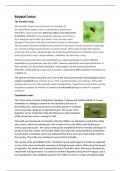Biological Control
The Parasitic wasp:
The parasitic wasp Encarsia formosa is a member of
the Aphelinidae family, and is a parastitoid of greenhouse
Whiteflies, most commonly, Bemisia tabaci and Aleyrodes
proletella. Whiteflies cause extensive damage and crop loss
by sucking the sap of their host plants. They can also cause
damage to the plants with their excrement, known as honeydew.
The honeydew that the whiteflies leave behind on the plant’s leaves can lead to outbreaks
of a variety of fungal species known as sooty moulds. These sooty moulds then spread
across the leaf surface, blocking light and restricting photosynthesis. Whitefly saliva is also
toxic to the plant, and, in large numbers, whiteflies can decimate a crop.
Encarsia formosa has been used worldwide as a natural pesticide to control whitefly
populations in greenhouses since the 1920s, however particularly in Europe and Russia. In
New Zealand, it is the primary biological control agent used to control greenhouse
whiteflies, particularly on crops such as tomato, a particularly difficult plant for predators to
establish on.
The species has been successful and is one of the most commercially used biological control
systems worldwide.Van Lenteren et al., 1977; van Roermund & van Lenteren, 1993, after
studying the success of the parasitic wasp concluded that “Encarsia formosa shows a strong
functional response to whitefly on tomato and successful biological control is regularly
achieved.”
Cactoblastis moth:
The Cactus moth is native to Argentina, Paraguay, Uruguay and southern Brazil. It is used
worldwide as a biological control for the Opunitia Cacti such as
the prickly pear, which has become an invasive species in countries
such as Australia, acting as an agricultural pest. The larvae of the
Argentine cactus moth feed inside the thick green pads (Cladodes)
of the prickly pear cactus, causing it to die.
The moth was introduced to Australia in the late 1800s in an attempt to control the prickly
pear cactus, which was introduced to the country in the early 1800s and had become a
serious agricultural pest. The cactus moth quickly established itself in Australia and began to
spread across the country. By the early 1900s, the moth had reached epidemic proportions
in some parts of Australia, and it was estimated that there were up to 100 million moths in
the country. The moth was considered a pest itself in Australia.
The release of the cactoblastis moth, a biological weed control agent, in 1926 was regarded
as one of the most remarkable exemplars of biological weed control. After being discovered
in Argentina, the moths were transported back to Australia, where they were released into
inland NSW and Queensland. It is native to northern Argentina and parts of Paraguay, but it
was introduced to the Caribbean islands in the 1960s to control a variety of (native) prickly





